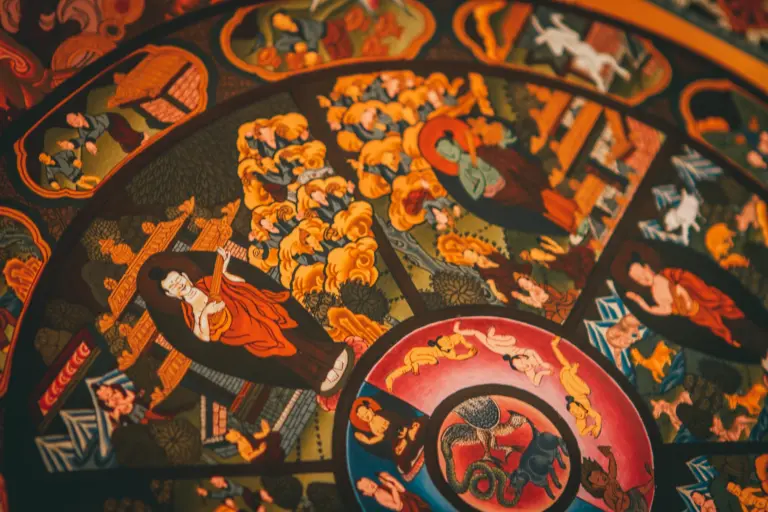In the pantheon of ancient languages, few have held such enduring fascination and profound influence as Sanskrit. But why is Sanskrit so powerful? What secrets does this timeless language hold? With roots burrowing deep into the dawn of human civilization, Sanskrit has been revered as the philosophical language of Hinduism, Buddhism, and Jainism.
A linguistic forebearer to many modern languages hence earning it the moniker of the “Mother of All Languages.”
To add to that, some even refer to it as the “Language of the Gods” as it carries within its intricate structure and profound depth, an alluring mystique that transcends time.
Sanskrit has played a huge role in my life in the form of mantras. I really do believe that this language carries with it a certain vibration that resonates with our being as humans. It’s something that I have integrated into my daily life, even while traveling!
So in this article, I’d like to share with you its linguistic charms, spiritual significance, and the powerful resonance it still holds in this modern age.
Table of Contents
Toggle
History of Sanskrit
Sanskrit, a classical language of India, boasts a rich and storied history that spans millennia. Its roots trace back to the second millennium BCE, in what is now modern-day Pakistan and Northwest India, making it one of the world’s oldest known languages.
The earliest form of Sanskrit is known as Vedic Sanskrit, which was the language of the sacred hymns and rituals of the ancient Indo-Aryans. These texts, known as the Vedas, are the oldest scriptures of Hinduism and were orally transmitted for generations before they were eventually written down.
By around the mid-first millennium BCE, Classical Sanskrit began to emerge, codified by the ancient grammarian Panini in his work, Ashtadhyayi. This work set the grammatical framework for Classical Sanskrit, which has remained largely unchanged to this day.
Throughout its history, Sanskrit has been the language of the educated and the elite. It was used extensively in literature, philosophy, science, and mathematics, with many key works in these fields written in Sanskrit.
Despite the rise of regional languages in India, Sanskrit maintained its status due to its role in religion, education, and governance. In the modern era, Sanskrit is less commonly spoken, but its influence is still profound. It’s studied for its literary and religious value and has significantly influenced many modern Indian languages.

Sanskrit's Influence and Usage Today
Despite the rise of regional languages in India, Sanskrit maintained its status due to its role in religion, education, and governance. In the modern era, Sanskrit is less commonly spoken, but its influence is still profound.
It’s studied for its literary and religious value and has significantly influenced many modern Indian languages.
Sanskrit is still used to this day through Hindu and Buddhist mantras during religious ceremonies or meditative practices, preserving the sacred resonance of this ancient language. It’s also used in yoga practices, where poses (asanas) are named in Sanskrit and chanting of Sanskrit mantras is common.
Sanskrit as the Mother of All Languages
While it might be an oversimplification to label Sanskrit as the “Mother of All Languages,” it’s undeniable that it has had a significant impact on many languages, especially within the Indo-European language family.
Sanskrit is a member of the Indo-European language family, which includes over 400 languages and dialects, including English, Spanish, German, Russian, Persian, and Hindi, among others.
Many of these languages share common roots and structures, suggesting a common ancestral language often referred to as Proto-Indo-European.
A significant number of words in modern Indian languages derive from Sanskrit. For instance, the Hindi words “karma” (action), “guru” (teacher), and “yoga” (union) come directly from Sanskrit. Similarly, many other South Asian languages, including Bengali, Punjabi, and Marathi, contain a wealth of Sanskrit-derived words.
Moreover, Sanskrit’s influence stretches beyond South Asia. For example, many English words have Sanskrit roots via intermediary languages. The English word “mother,” for instance, is “matr” in Sanskrit.
Sanskrit also has had a significant influence on several languages in Southeast Asia such as Laos, Vietnam, Thailand, Cambodia, the Philippines, Indonesia, and Malaysia. This influence came primarily during the first few centuries CE, when Indian merchants and Hindu and Buddhist monks brought Indian culture, and with it, Sanskrit, to the region.

Why is Sanskrit so Powerful?
Sanskrit’s power is deeply embedded in its intricate structure, meticulous grammar, and profound phonetics that set it apart from many other languages.
-
Phonetics and pronunciation: Sanskrit is an entirely phonetic language, which means words are written precisely as they are pronounced. This feature reduces ambiguity in speech and contributes to the language’s clarity. Additionally, the Sanskrit alphabet, or Devanagari script, has a systematic arrangement of consonants and vowels, making it a pleasure to learn and recite.
-
Grammar and structure: Sanskrit grammar, as systematized by the ancient grammarian Panini, is precise and comprehensive. It’s incredibly systematic, with a clear structure that is both elegant and efficient. This complexity allows for nuanced expressions that can encapsulate complex ideas in compact phrases.
-
Vibrational quality: Some scholars believe that Sanskrit’s power also lies in its vibrational quality. Each sound or syllable in Sanskrit is believed to correspond to a particular vibration in the universe. Especially the Sanskrit syllable “Om” which is one of the symbols used to represent Hinduism and is just as important in Buddhism. This aspect is especially relevant in spiritual practices, where mantras (sounds or phrases in Sanskrit) are believed to produce specific effects based on their vibrational quality.
-
Versatility: The versatility of Sanskrit is another aspect of its power. It can accurately describe a wide range of human experiences and philosophical concepts. This is why it was used to compose everything from epic tales such as the Ramayana and Mahabharata to dense philosophical treatises.
-
Continuity: Despite being thousands of years old, Sanskrit has enjoyed a remarkable continuity. Ancient scriptures are still read and understood in their original form without the need for translation within the linguistic community. This factor testifies to the timelessness of the language.
-
Influence: As discussed, Sanskrit’s influence on many modern languages also contributes to its power. It has served as a linguistic wellspring from which many languages have drawn vocabulary and elements of structure.

Sanskrit as the Language of the Gods
The epithet “Language of the Gods” for Sanskrit underscores its profound spiritual significance and divine associations. Here’s why:
-
Sacred Texts: Many of the world’s oldest spiritual texts, including the Vedas, Upanishads, Bhagavad Gita, and various Buddhist and Jain scriptures, were written in Sanskrit. These texts are considered divine revelations or profound philosophical discourses that provide insights into human existence and the nature of the universe. The use of Sanskrit in these sacred texts contributed to its reputation as a divine language.
-
Mantras and Rituals: Sanskrit is the language of Hindu and Buddhist mantras, sacred sounds or phrases believed to have spiritual power. Mantras are used in meditation and rituals, and they’re said to bring about specific spiritual or psychological effects. The chanting of Sanskrit mantras is believed to connect the individual with the divine.
-
Language of the Gods: In Hinduism, it is believed that the gods communicate in Sanskrit. It is said that Sanskrit was created and given to rishis (sages) by Brahma, the Hindu god of creation. This is another reason why Sanskrit is often referred to as “Devavani” or “Deva Bhasha”, both of which mean “Language of the Gods”. In the Indian epic Mahabharata, the story goes that the sage Vyasa composed the epic in Sanskrit under the dictate of Lord Ganesha, the elephant god and the remover of obstacles. This belief further enhances its divine status.
-
Metaphysical Attributes: Some scholars argue that the vibrational qualities of Sanskrit have spiritual and healing properties. The sounds of Sanskrit are believed to correspond to the chakras (energy centers) in the body, and chanting Sanskrit mantras is believed to help balance these energy centers.
-
Preservation of Spiritual Concepts: Sanskrit has preserved spiritual concepts that may not be easily translatable into other languages. The subtlety and complexity of these concepts are often best understood in their original Sanskrit form.













